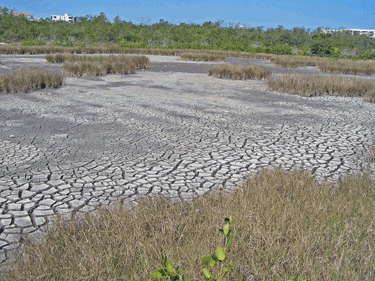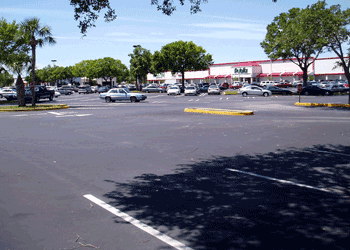Why Pervious Concrete?

Pervious Concrete is a serious answer to a serious problem. That problem is that our land is drying up. Not only are we experiencing climate change but now 35% to 70% of our construction sites are being covered by paved surfaces and roofs as urban sprawl continues to dominate the landscape. The result is that our aquifers are dying of thirst. This is very evident when droughts dry up wading ponds like the one here where ducks usually reproduce in the spring.
What happens when it rains on impervious surfaces? The water that is badly needed by the aquifer turns into storm water, which is not only wasteful, but it can be destructive as well, when it results in flooding and the pollution of our streams and waterways.
Those same impervious surfaces convert sunlight into heat and add to the air conditioning burden well into the night. No wonder then that the EPA points to Pervious Concrete as a best management practice (BMP) for managing storm water.

This shopping center while having some green areas has approximately 462,000 square feet of impervious surface.
It converts 1½” of rainfall into approximately 432,000 gallons of storm water. That’s enough to keep the pond seen here full.
If it were paved with pervious concrete that storm water could help recharge our aquifer, repelling salt water intrusion.
When impervious surfaces are within a townhouse project, though the percentage of grass and trees may be greater, there is still much rain water that is wasted when it is turned into storm water. Even though a retention pond may be on site, in a heavy rain the pond will overflow, and the overflow will wind up wasted into the gulf or some other body of water. What is left behind contains a variety of pollutants including pesticides.

This townhouse development with 136 residences creates about 344,600 square feet of impervious surfaces including roads, parking and roofs. During a 1½” rain fall approximately 318,000 gallons of rain water will be diverted to a retention pond. There pollutants will be concentrated. Depending upon how quickly that 1½” falls, some of that rain water will overflow into nearby estuaries and change the chemistry of the water.

During a 1½” rain fall this pervious concrete street in Indian Shores, Florida, directs more than 9,000 gallons of rain water through a compacted base of sand into the aquifer below rather than flooding surrounding streets. This helps to fight salt water intrusion. That 1½” first flush filters out the heavy pollution that first flush contains, namely oil, grease, heavy metal, rubber particles from tires and pesticides.
Some questions that arise are, why should you be interested in pervious concrete, or why should you use it or encourage its use?
If you are concerned about things such as shrinking supply of good water, contamination of the aquifer, damage from storm water, air quality, or global warming then you will be interested to read about how pervious concrete can be used to combat these issues.
